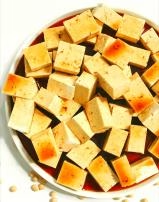Ever wondered why foods like fermented tofu, stinky tofu, and cheese have such a pungent odor? Why are they all made with mold? Fermented tofu, an essential Chinese condiment, is said to have existed in China or Okinawa as early as 1500. Mold is also responsible for curdling milk into cheese. How did these smellier, yet more delicious, foods come about?
Mucor Fermented Tofu and Mucor Miehei
Eating and Brewing.
Foods fermented with Mucor, such as cheese in the West and fermented tofu in the East, have been unique delicacies with a distinct flavor since ancient times. The origin of fermented tofu is unclear; some say it dates to China in 1500, while others say it originated on the small islands surrounding Okinawa.
The Gold Rush of Fermented Tofu
Fermented Tofu Brewing Methods
There are two main methods for making fermented tofu: salting before mold growth or salting after mold growth. For the latter method, the tofu is first inoculated with spores and then kept in a warm place (incubated) for several days until each cube is covered with white mycelium. The moldy tofu is then immersed in a wine-salt mixture (a mixture of rice wine, water, and salt) and left to mature at room temperature.
This process usually takes several years. If the moldy tofu is fried directly without salting, it becomes stinky tofu.
History of Tofu
According to legend, Liu An, King of Huainan (179-122 BC), convened various parties to co-author the Huainanzi, which mentions tofu and is considered the inventor of tofu. By the Qing Dynasty, Li Huanan’s Xingyuanlu detailed the method of making fermented tofu. The first record of fermented tofu appeared in Japanese literature in 1783, in Tofu Baizhen Xubian, written by Osaka Hebijun. In 1818, Basil Hall Chamberlain, the first Englishman to teach Japanese literature at Tokyo Imperial University, wrote about a banquet hosted by the Ryukyu King during his visit to Ryukyu:
“There was something very much like cheese, such as we often have after cake, but I could neither tell nor guess what it was made of.” It is speculated that the food Captain Hall saw was fermented tofu.
In 1858, Chinese gold miners in Australia brought fermented tofu with them, as it would not spoil during the long journey. Fermented tofu was subsequently brought to San Francisco in 1878 and appeared in the Hartford Daily Courant the following year, where an article referred to it as “salted tofu.” In 1882, fermented tofu arrived in France, where it received its official Western name, fromage de soja.
The Mother of Cheese: Rennet
Mucor miehei is a thermophilic bacterium that can withstand temperatures exceeding 50°C, making it suitable for producing heat-resistant enzymes. Mucor miehei produces lipase, which plays a crucial role in the breakdown, transport, and conversion of dietary fats. It was once an essential component in ancient yogurt and cheese making.
Genetic engineering has now made recombinant lipases affordable and versatile, with applications such as bread baking, detergents, and even as alternative energy biocatalysts for converting vegetable oils into fuel.
Additionally, cosmetic and skincare additives often utilize immobilized Mucor miehei lipases for esterification.
Chennet Production and Uses
In addition to lipase, Mucor miehei can also produce rennet. Rennet is a protease that coagulates casein in milk, helping young mammals digest their mother’s milk. In the past, cheesemaking required slaughtering calves or lambs to obtain rennet from their abomasum lining. The traditional method involves cutting the calf’s stomach into small pieces, cleaning and drying them, then adding salt water or whey, along with some vinegar or wine to lower the solution’s pH. After a period of time (usually overnight or several days), the solution is filtered. Crude rennet remains in the filtered solution, and approximately one milliliter can normally coagulate two to four liters of milk.
Since the production of rennet from animals is limited, cheesemakers have been exploring other methods of coagulating milk since Roman times, such as those produced by microorganisms such as plants and fungi.
Many plants have coagulating properties. For example, the Greeks used fig juice extract to coagulate milk. Others, such as dried caper leaves, nettles, thistles, mallow, and ground ivy, have similar properties. Plant-based curds are suitable for vegetarians, and commercially available vegetarian curds are typically made from the fungus Mucor miehei.


Leave a Reply